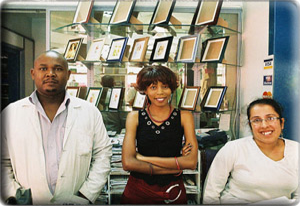insbesondere danke ich: phoebe akinyi • brian amuyunzu • andreas • michael atieri • tony ayiera • myriam und felix baele • mbanjwa bandlakazi • ralf beckamp • inge berger • bulelani bobotyana • nonkosi boyle • miss. v.m. budaza (maggie) • neil clayton • mohamed daoud • iain delaney • gerlinde dombrowski • christina gauding • melikoa gonqxoza • thumeka gwita • luke hefson • bettina helfenritter • johannes hossfeld • biko huester • paul hütte • joyce inziani • isaac • mark james • nolusindiso joja • jonathan • jill joubert • mafunda khuthala • alison kingsley-hall • peter kinyanjui • sr. leah • matyhintyala lihle • www.loghound.com • anthony macharia • francis maina • regula manser • nokubonga madyolo • nomuuzo makhonza • luvuyo mandyli • phikelemzi ceasar mashiya • salman matemba • tiny mathe • alice mbenyi • alfred mazaka • samkelele mbebe • lundi mbityana • andile mbobi • john mclaughlin • mendiswa • ntomboyse mgaba • mirella • janele mkhaba • monica • zaza msindise • elvis ndiki • lubabalo ndongeni • molukhanyo ngqeleni • nompumelelo nhebi • ann njambi • joseph njau • thozama nkgayi • thobela nkiwana • nobesuthu • mador nobomuu • falangile nozandine • siyo odwa • pravin patel • carolyn peters • irmingard pinske • gcobani potso • sarat pradhan • barbara reich • annika rudolph • stella rudolph • samuel • wolfgang sandig • stefan schaar • siegfried schmerbeck • andy schmitt :-) • monika schoeller • iris schürch • gabriele shettle • sidumo sibulelo • zoliswa silomo • collin stevens (und errol) • maike stoehr • thandisizwe (ta-charlie) • mbadambdna thando • miss tole • yaso vugokazi • wolfgang weber • hlobo xolelwa • ...
ohne die tatkräftige unterstützung und das wohlwollen vieler lieber menschen, wäre es nicht möglich gewesen, das projekt bis hierher zu bringen.
ich möchte allen für ihre hilfe, ihre spenden und preisnachlässe, ihre geduld, spät- und nachtschichten sowie ihre zugedrückten augen und offenen ohren danken und für ihr vertrauen in mich und meine ideen.
außerdem möchte ich den lokalen lehrkräften, schulleitern/leiterinnen für ihre gastfreundschaft und ihren rat danken.
und natürlich danke ich den schüler und schülerinnen, pupils, students und learners für die freizeit und unterichtsstunden, für verrückte ideen und tolle scherze und fürs dranbleiben.
danke!
p.s.: wenn du lust hast kannst du helfen diese seiten zu übersetzen. gebraucht wird französisch, holländisch, spanisch und italienisch unter download gibt es eine worddatei...
ich möchte allen für ihre hilfe, ihre spenden und preisnachlässe, ihre geduld, spät- und nachtschichten sowie ihre zugedrückten augen und offenen ohren danken und für ihr vertrauen in mich und meine ideen.
außerdem möchte ich den lokalen lehrkräften, schulleitern/leiterinnen für ihre gastfreundschaft und ihren rat danken.
und natürlich danke ich den schüler und schülerinnen, pupils, students und learners für die freizeit und unterichtsstunden, für verrückte ideen und tolle scherze und fürs dranbleiben.
danke!
p.s.: wenn du lust hast kannst du helfen diese seiten zu übersetzen. gebraucht wird französisch, holländisch, spanisch und italienisch unter download gibt es eine worddatei...













